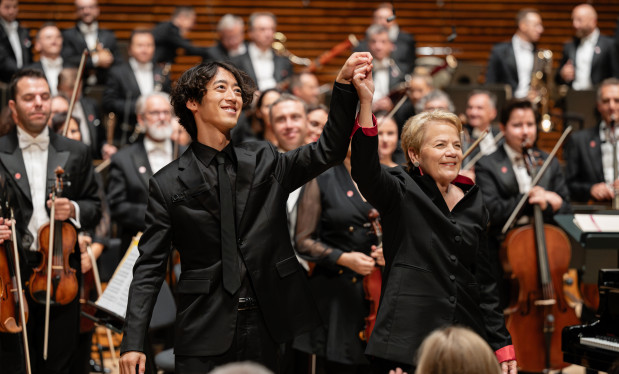NOSPR / Alsop / Season finale. A Titan - NOSPR
NOSPR / Alsop / Season finale. A Titan
It is rare for “first” symphonies to be created in a spontaneous rapture of inspiration. The creative process may last more than a dozen years. Sometimes it is only the “second” that becomes the “first”, and at other times it only takes its final shape after emerging from a formal ambiguity. The one to blame for all this is the author of the “Eroica”, who set the bar so high that it is difficult for his successors to get rid of the Beethovenian complex.
Grażyna Bacewicz had already composed her “first” Symphony No. 1 before the war. Nonetheless, dissatisfied with the result, she “renounced” that child of hers and did not enter it into the official catalogue of works. She returned to the symphonic form in 1945, creating a four-movement neoclassical work marked by the wartime trauma. It was this symphony that she eventually gave the official number one. In spite of the fact that the work was performed by a Cracow symphony, however, she decided against publishing it.
Mahler was twenty-eight years old when he finished the Symphony No. 1 and titled it Titan, thus referencing a novel by Jean Paul, a prophet of Romantic literature. Seeking a form capable of accommodating all the compositional ideas which crowded his mind, he must have experienced much more quandaries than the Polish composer did. He spent a long time adjusting the form and defining the genre for his Symphony No. 1. He hesitated between various shades and incarnations of the wide-spanning form of tone poem, alternately adding and removing the literary programme.
The piece, which Mahler presented for the first time in Budapest on 20th November 1889, was introduced as A tone poem in two parts, the first part encompassing three movements of the cycle, and the second one encompassing two of them. Mahler lent them a full spectrum of emotional shades – from subjective and philosophical ones, to grotesque folklore. He initially gave each movement a programme title, only to remove those later. Thus, as a symphonist, he took the side of absolute music. After reducing the cycle to four movements, he defined his piece as Titan, a tone poem in symphonic form, in order to eventually announce, to himself and to the world, what a symphony is, and to redefine the term.
Andrzej Sułek
Concert duration (intermission included): approximately 110 minutes
Upcoming events

Japan tournée / NOSPR / Marin Alsop / Hayato Sumino / Masaya Kamei
Tokyo Opera City

Japan tournée / NOSPR / Marin Alsop / Hayato Sumino
Toyama, Aubade Hall

Japan tournée / NOSPR / Marin Alsop / Hayato Sumino
Osaka, The Symphony Hall

Japan tournée / NOSPR / Marin Alsop / Hayato Sumino
Kurashiki Shimin Hall

Japan tournée / NOSPR / Marin Alsop / Hayato Sumino
Yokohama, Minato Mirai Hall

Japan tournée / NOSPR / Marin Alsop / Hayato Sumino
Tokio, Suntory Hall

Japan tournée / NOSPR / Marin Alsop / Hayato Sumino
Nagoya, Aichi Prefectural Art Theater

Japan tournée / NOSPR / Marin Alsop / Hayato Sumino
Tokorozawa Muse

Japan tournée / NOSPR / Marin Alsop / Hayato Sumino
Chiba, Ichikawa Shimin Hall






